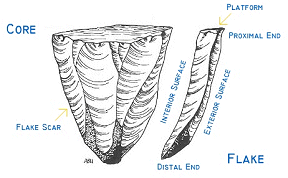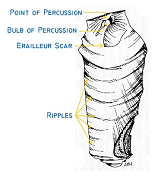How our ancestors made Stone Age tools
Stone age people discovered, perhaps more than a million years ago, that flint could be used to make tools. Flint is one of the hardest rocks and fractures easily to give razor sharp edges.
By around 500,000 years ago, in the early stone age or Palaeolithic period, humans had developed great skill at fashioning beautiful tools such as the hand axe above. Later, in the Mesolithic or middle stone age, they developed skills at making flake tools including tiny Microliths that could be mounted in a wooden shaft to make arrows or spears. In the Neolithic or new stone age, they made intricately flaked tools such as scythes and polished axes.
The processes they used are relatively simple, and leave distinctive marks on the tools they made. If you get a suitable large piece of flint (or core) and strike it near the edge with a hammer stone or round pebble, you will break off a flint flake. To get decent sized, usable flakes, you need to prepare the striking surface or platform so it is flat and at a little less than 90 degrees to the face of the core.
Bulbs of percussion and strike mark
When a flint knapper strikes the platform of his/her core with a hammer stone, a flake is removed bearing a distinctive mark of the impact. This takes the form of a sharp lump that juts out just below the point of impact and often a bulge that tapers away down the length flake in the direction in which it was struck. This is called a positive bulb of percussion. There is a corresponding concave or negative bulb left behind on the flint core from which the flake was struck.
If the toolmaker then strikes another flake from the same place, but a few millimetres further back from the platform edge, the thin flake that comes away will have a positive bulb of percussion on the back and a negative bulb of percussion on the front, giving a very distinctive curve to the side view or section through the flake.


Sometimes, the toolmaker will prepare his or her target flake, taking off some long thin preparatory flakes, creating shallow facets on the core (usually with a triangular section, or a triangle with the top sliced off – see picture) and then striking off the target flake, which will have two or three shallow facets on the back with little bulbs of percussion, and a big bulb on a single facet on the front.
Often the strike mark or point of impact of the hammer stone is visible on the top of the flake, sometimes surrounded by a small ring of crushed, whitened, flint.
Ripples
Because flint shatters like glass, In many cases there will also be concentric ripples spreading out from the point of impact, in the direction of the blow along the surface of the flake scar, like ripples in a pond. These can also indicate the direction of the blow and if there are a number of flake scars can be evidence of human manufacture
Bulbar scar or Erailleur scar
It occasionally happens that a small, thin flake extra flake will ‘pop’ off the surface just below the positive bulb of percussion when struck sharply. This can be a useful additional indication of human manufacture.
One particular method of working, named after the town of Levallois in France, is to prepare the outside of a core by chipping small flakes, leaving a tortoiseshell shaped dome, and then to strike off the middle with a single well-aimed blow. The resulting Levalloisian flakes are very distinctive
Work on both faces
Once a flint knapper has removed the first few flakes from a core, then each flake he or she knocks off will have signs of the previous flakes having been removed from the back. So the tool will show signs of having been worked on both faces.
Retouching
When an ancient toolmaker produced a promising flint flake, he or she would usually perfect it for use by retouching one or more edges. Re-touching maybe done to make an edge sharper or more usable, but it is also sometimes done to blunt a razor sharp edge so that a blade can be held comfortably, or bound to a shaft with a leather thong and not cut the leather.